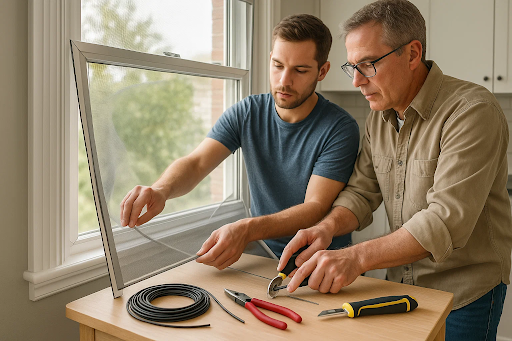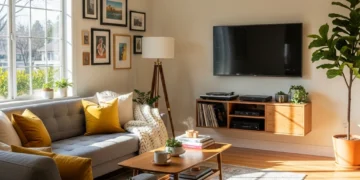Bent or warped window screens make any home look tired. But fixing them DIY is simpler than it sounds.
You might as well be surprised, how easy a sturdy repair can be with just a few basic tools. Clear steps show how to measure the opening, cut replacement bars, and install mesh that stays tight season after season.
Curious about adding years of life to your screens?
Read on for friendly tips and straightforward solutions.
Checking Your Window Screen for Damage
You first of all want to know how badly bent or warped your window screens are. This means assessing every side and corner with gentle pressure from your hand, looking for spots where the frame wobbles or mesh pulls loose.
Pay close attention to corners, since these points often show the earliest signs of stress. Finding a few tight bends early can save time later when it comes to repairs that last.
Choosing Materials and Tools for Repairs
You need the right supplies to keep a repair job simple and strong. Think of aluminum bars for replacement, mesh that suits your climate, spline to hold the mesh tight, plus a flat-head screwdriver or rolling tool.
Keep a tape measure close at hand so every cut fits with precision. Sturdy scissors work best for trimming mesh without leaving rough edges behind. When assessing frame strength, you can use a screen door frame as a practical example to gauge the durability you’ll want in a replacement.
Removing and Straightening the Frame
It helps to gently ease your window screen from its track, using steady hands so nothing twists further out of shape.
Work on a flat surface for better control while inspecting every section for obvious bends or dents. Sometimes you can smooth slight curves by pressing along the length with a block of wood.
Cutting New Mesh to Fit Correctly
Accurate cuts make the biggest difference. Lay your frame flat and place the mesh over it with a little extra on all sides. Trim along the edge using sharp scissors for neat results, keeping tension even across the surface.
This care prevents future sagging while also blocking insects from sneaking in. Talk of supporting a healthier, more sustainable lifestyle right at home with fewer chemical sprays or wasteful replacements.
Reinforcing Corners for Lasting Results
Corners see the most strain. Tuck in metal corner inserts or apply a dab of strong epoxy to keep joints tight. Slide the pieces back together and check everything is square with a carpenter’s tool.
Properly supported corners help your screen stand up to wind, pets, and cleaning year after year without losing shape.
Tips to Prevent Future Warping
Good maintenance is simpler than fixing the same problem twice. Start by choosing quality aluminum or fiberglass mesh, then store unused screens flat in a dry spot away from direct sunlight.
- Wipe frames with a damp cloth every few months
- Avoid heavy pressure when opening or closing windows
- Store screens upright only if they have rigid supports
- Tighten loose spline ends before sagging appears
These steps slow down damage, making every screen repair count for longer. Clean frames and snug mesh go further when you avoid habits that weaken the structure over time.
Window screens that fit well and hold strong play a quiet role in home comfort. Thoughtful repairs make a difference, protecting living spaces as well as your daily peace of mind.












